Table of Contents
The Chronicle of Deeds
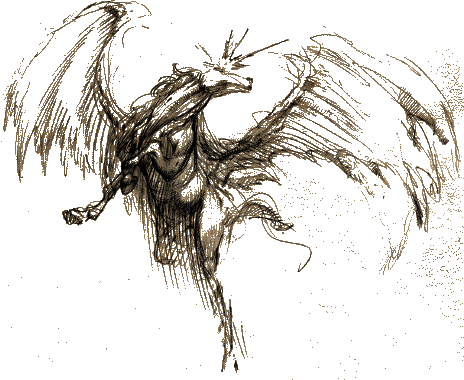 It was precisely one year ago that
Eidolon came to our world of Thyrion. On the evening
before his arrival, a rain of fire streamed down from the
sky, scorching citizens and buildings alike on the four
continents of our fair planet. By dawn the populace was
fearful and demoralized, and they fell quickly before the
march of Eidolon’s vile Golems. The attack was bold
and carefully executed. All four continents had fallen by
midday: a sad tribute to the withered resistance of our
four mighty nations. Even now I am shamed to think of it. It was precisely one year ago that
Eidolon came to our world of Thyrion. On the evening
before his arrival, a rain of fire streamed down from the
sky, scorching citizens and buildings alike on the four
continents of our fair planet. By dawn the populace was
fearful and demoralized, and they fell quickly before the
march of Eidolon’s vile Golems. The attack was bold
and carefully executed. All four continents had fallen by
midday: a sad tribute to the withered resistance of our
four mighty nations. Even now I am shamed to think of it.Now, a full year after the conquest,
Thyrion still huddles in a state of constant fear and
dread. The conquest has ended, and many humans yet
survive–but in these times of trouble, life itself
is a meager blessing. Eidolon’s minions overrun the
land and kill its populace for sport. The cleverest
humans make themselves unobtrusive, avoiding
Eidolon’s creatures and attempting little more than
to survive. It is under these dreary conditions that I
write the manuscript you now hold in your hands.
|
Legacy of the Serpent Riders
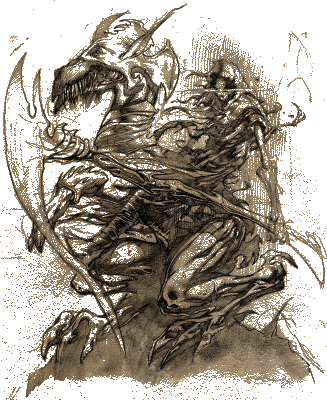 Several hundred
years ago, in the time we now call the Age of Dreams,
there were rumors of the Serpent Riders. The Serpent
Riders were a trio of horrifying demons, wielding
powerful magic and commanding vast, formidable armies.
They possessed the power to travel from world to
world–and everywhere they went, they spread chaos
and despair. Their motives were unclear, but their goals
were obvious: they wished to possess. That which they
could not possess, they strove to destroy. No world was
immune, not even our beloved Thyrion. Several hundred
years ago, in the time we now call the Age of Dreams,
there were rumors of the Serpent Riders. The Serpent
Riders were a trio of horrifying demons, wielding
powerful magic and commanding vast, formidable armies.
They possessed the power to travel from world to
world–and everywhere they went, they spread chaos
and despair. Their motives were unclear, but their goals
were obvious: they wished to possess. That which they
could not possess, they strove to destroy. No world was
immune, not even our beloved Thyrion.So went the rumors, but few took heed.
Some dismissed them as the ravings of a madman, or as
fairy tales told to frighten children. Others disputed
the very foundation of the stories, denying the existence
of worlds beyond our own. And still others took comfort
in obscurity: if other worlds did indeed exist, why
should the Serpent Riders trouble themselves with
Thyrion?
How na∩ve, in retrospect, were
our great civilizations. The portents were numerous and
easily read, but none–not even I, Sage of
Mur–gave them more than a cursory glance. And now we
have paid for our ignorance, as all that was prophesied
has come to pass. The four great continents of our world
have been overrun by demonic hordes, their denizens
crushed, scattered, and cruelly enslaved.
Our world is, by any measure,
utterly lost–and yet I cannot bring myself to
believe it. Despite all that I have seen, I assure myself
that salvation is yet possible. To this end I write the
volume you now see before you. It is a history of the
Serpent Riders’ assault on our world, and,
hopefully, the counterattack that will free us of their
dominion.
At present time, the populace
has little fuel for hope. None have risen to challenge
the dark armies of Eidolon. Still, I continue to maintain
my faith. In dreams and visions I have seen a band of
unlikely saviors, a defiant flicker in the darkness that
cloaks our world. Who these heroes are, I cannot
say–but I shall present my visions in the pages of
this chronicle.
My visions, in fact, are our
only reason for hope. They suggest an end to
Eidolon’s reign, and the possibility of our
world’s restoration. Instead of calling this history
The Fall of Thyrion, therefore, I have named it The
Chronicle of Deeds, after the deeds of unknown warriors
that will hopefully save us all. These deeds may never be
realized, but I steadfastly maintain that they
must–for I shudder to think of the alternative.
- Themedes, Sage of Mur
|
The
Serpent Riders
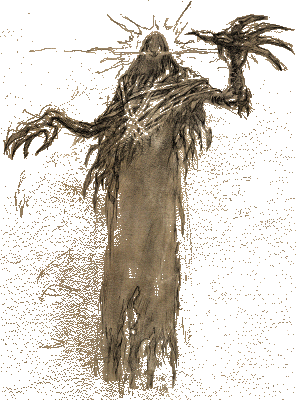 In ages past, the steppe dwellers of
Kazul-Mokh prophesied the coming of Eidolon and his
brethren. But to understand their stories, one must first
understand their view of the universe. In ages past, the steppe dwellers of
Kazul-Mokh prophesied the coming of Eidolon and his
brethren. But to understand their stories, one must first
understand their view of the universe. In the steppe dwellers’ eyes,
Thyrion is just one of many worlds. The other worlds of
our universe appear as stars in the evening sky. By the
steppe dwellers’ reckoning, there are precisely one
thousand worlds besides our own, each appearing a single
brilliant star. But this view of the universe posits many
questions. What lies between the stars? What holds each
world in place?
According to the steppe
dwellers, the universe is filled with a clear but viscous
gas known as Aether. The Aether is to the universe what
water is to the ocean; it holds the stars in place, and
fills the void between them. A great crystal sphere
encircles the Aether, preventing it from escaping. Beyond
this celestial sphere lies darkness: the very darkness we
see when the sun sinks below the horizon. This darkness
is an uncharted land of powerful demons and evil spirits,
each slavering to crush our petty worlds, but prevented
by the great crystal barrier.
The steppe dwellers tell of a
brilliant magician who, seeking to travel to distant
worlds, fashioned a ship of ironwood and silver to
journey through the Aether. When the ship was complete he
climbed aboard and sailed into the night, just as a
mariner would take to the seas. The journey proceeded
smoothly for countless days, but then disaster struck:
the ship’s gossamer sails were torn in a great storm
of Aether. Unable to steer or otherwise control his
craft, the helpless magician watched his ship glide past
the brilliant stars he had hoped to visit. Closer and
closer loomed the celestial sphere, and the darkness
beyond; the magician watched it approach with a mixture
of dread and fascination.
Finally, the magical ship
collided with the barrier. The vessel’s silver prow
punctured the crystal sphere and cracked it open,
allowing a trio of demons from the darkness beyond to
slip into our universe. Horrified at the tragedy he had
caused, the magician worked a final, mighty spell to
close the rift, exchanging his life for the power to seal
the cosmic barrier. He died quietly in the darkness
between worlds, wondering if our universe would survive
the terror he had unleashed. He would never know the
answer, and neither, yet, do we.
So goes the story. Whether truth
or fiction, it remains our best guess as to the origin of
the Serpent Riders. Many have dismissed this tale as mere
superstition, but I choose to believe it. Why? Just as
the steppe dwellers foretold the arrival of the Serpent
Riders, they also foretold the trio’s demise. For
this reason alone, I fervently hope their prophecies are
correct.
|
 D’Sparil D’Sparil
According to the
texts of Yavenar the Astromancer, the Serpent
Riders’ first attack occurred two thousand years
ago, on a remote world whose name is forever lost. This
world was a place of dense population and seven mighty
nations. The Serpent Riders subjugated the world’s
seven great leaders by trickery and guile, for they had
not yet attained their full power in this universe, and
could not crush the world through forthright aggression.
One by one the nations fell, as if by clockwork; their
corruption and decayed traditions had left them
vulnerable to the Serpent Riders’ deception.When the seven great nations had been
subverted, they were left to fight amongst themselves.
D’Sparil, the youngest and weakest of the Serpent
Riders, was left behind to act as puppeteer. He gleefully
pulled the strings of each nation, pitting former allies
against each other, and sending peaceful nations to
battle. He planned to continue this cruel game until
every nation had collapsed under the weight of war and
famine. The two elders, meanwhile, departed. It was their
intention to wreak havoc in new and unsuspecting worlds.
Only the Sidhe, a race of
heretical elves hiding in the secret places of the world,
were left untouched by the Serpent Riders’ poison.
Recognizing the threat to their world, the Sidhe elders
contrived a mighty spell that crushed the greatest of the
Serpent Riders’ armies, leaving behind only a
fraction of the mighty horde. But D’Sparil, sensing
the source of the magic, retaliated with a storm of pure
energy that killed the elders to a man.
In the wake of this great
magical battle, with the world apparently withered beyond
salvation, a single nameless Sidhe assaulted
D’Sparil’s stronghold: The City of the Damned.
Using the Sidhe elders’ Tomes of Power, mighty
artifacts that enhanced the properties of his weapons,
this lone elf scored an improbable victory against the
forces of evil. D’Sparil was crushed and his minions
killed or scattered. Though merely a shadow of its former
self, the world was finally free of the Serpent
Riders’ poisonous influence.
|
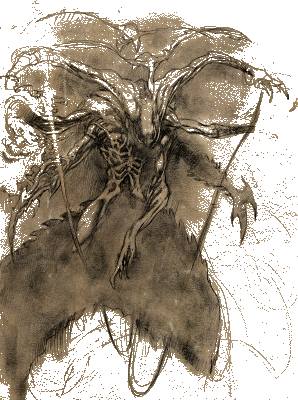 Korax Korax
The next target of
the Serpent Riders’ wrath was Cronos, a populous
human world. Cronos was a land of unification and
oppression, where all of humanity bowed to the
triumvirate of Legion, Arcanum, and Church. These three
institutions controlled every aspect of Cronos, each
exerting power over a meticulously defined sphere of
influence. As such, Cronos was both disciplined and
fragile: by subverting the leaders of these three
institutions, the Serpent Riders instantly gained control
of the entire world. Zedek, Marshal of the Legion,
Traductus, Grand Patriarch of the Church, and Menelkir,
Arch-Mage of the Arcanum succumbed quickly to the Serpent
Riders’ promises of immortal life.As before, a single Serpent Rider was
left behind once the world was largely enslaved. This
time it was Korax, the second most powerful Serpent
Rider.
On Cronos there was no such
thing as the Sidhe, no secret conclave to expunge
Korax’s grand army. But there were three brave souls
who fought against Korax’s might: Baratus of the
Legion, Parius of the Church, and Daedolon of the
Arcanum. Together, these three adventurers fought their
way through the twisted realms of Cronos, ultimately
defeating the chitinous horror that was Korax. Their
victory marked a grand day for all of humanity, once
again signaling the vulnerability of the dreaded Serpent
Riders.
|
Eidolon
Eidolon’s power is
immense, his grip on our world absolute. Some citizens believe
his hellish reign must come to an end, and look to the improbable
victories against D’Sparil and Korax for inspiration. But
for most, the future is uncompromisingly bleak. Eidolon, the
oldest and strongest of the Serpent Riders, is reputedly many
times more powerful than his vile brethren. He is certainly aware
of the weaknesses that led to the downfall of D’Sparil and
Korax, and will do his best to guard himself against similar
circumstances. Indeed, he has already taken such measures: in
addition to his own troops, he has surrounded himself with the
remnants of Korax’s and D’Sparil’s broken armies.
The task at hand is formidable. Whoever
challenges Eidolon must destroy his minions on all four
continents, then challenge Eidolon himself within his ebon
stronghold. The dangers are great, from beginning to end. The
dank jungles of Mazaera seethe with giant Scorpions and Spiders,
while the pyramids of Thysis are replete with Mummies and dreaded
Stone Golems. No less formidable are the horrors lurking in the
ruined cities of Septimus, or behind the crenelated walls of
Blackmarsh.
Despite all these travails, there is yet
another peril: the Four Horsemen of the Apocalypse, who serve
Eidolon as generals. Each governs one of the four great nations,
and each must be defeated to end Eidolon’s infernal
dominion. Can any hero, however powerful, face all these perils
and emerge victorious? Only time will tell.
The
Lands of Thyrion
What challenges and perils await those
who would strive against Eidolon’s might? Aside from
Eidolon’s ravening armies, the land itself presents
formidable challenges. For those unfamiliar with Thyrion, I will
now present a brief introduction.
Continents
Any hero wishing to clear
the land of Eidolon’s minions must visit all four of
Thyrion’s great continents: Blackmarsh, Mazaera, Thysis and
Septimus. These lands all possess their own unique perils and
challenges, many of which are unknown even to me.
Blackmarsh
A land of cold rain and
dark, decaying castles, Blackmarsh appears harsh and uninviting
to the casual visitor. It has become even less so since the
coming of Eidolon: once-quaint villages and fortresses have now
been overrun with Golems, Fallen Angels, and a host of other vile
creatures.
Any hero wishing to rid Blackmarsh of
evil would have to fight his or her way through several distinct
locales: the Grand Cathedral, the Underhalls, the Mage’s
Tower, and more. Eidolon’s minions have also infested the
sewers beneath Blackmarsh’s greatest cities–and these,
too, must be expunged of their evil denizens.
Eidolon’s inner sanctum is rumored
to lie somewhere within the lands of Blackmarsh, though none can
attest to this with any certainty.
Mazaera
Mazaera is a land of lush
rain forests and nomadic tribesmen. A few scattered centers of
civilization have been carved from the heart of Mazaera’s
steamy jungles, but the remainder of the continent remains
largely untouched by man.
Mazaera is filled with the ruins of
ancient civilizations, many of which have now been claimed by
Eidolon. The legendary Plaza of the Sun, Court of 1,000 Warriors,
and Tomb of the High Priest are all famous sites long since
overrun by vile beasts. Perhaps the most formidable of these
creatures is the lithe and deadly Were Jaguar, which makes its
home exclusively in Mazaera’s warm climate. Adventurers
beware!
Thysis
Thysis is a continent dominated by desert: only the land
adjoining the coast shows signs of abundant vegetation. Within
this barren desert, several great empires have risen and
crumbled–despite the apparent hardships of living in such a
hostile climate.
The distinctive culture of Thysis has
always seemed unusual to denizens of other continents, and is
shrouded with even more mystery since the coming of Eidolon. The
great pyramids of Thysis, both whole and ruined, have been
conquered by hordes of Mummies and Golems. The fantastical Palace
of Horus and the forbidding Temple of Set have likewise fallen to
Eidolon’s inexorable onslaught. Only the mightiest of heroes
will succeed in this strange, hostile land, where Scorpions run
rampant, and sealed tombs conceal horrors beyond mortal
imagination.
Septimus
The most heavily populated
of Thyrion’s four continents, Septimus is a land of urban
decadence. Its citizens are cosmopolitan, sampling the best that
Thyrion has to offer from the comfort of their richly appointed
palaces.
Unfortunately, the wealth and comfort of
Septimus bred complacency and sloth. Aside from the ascetic
devotees of Kravnos, Septimus’ citizens were ill prepared
for the coming of Eidolon. Septimus’ grand structures fell
within hours of Eidolon’s initial assault: the grand Forum,
the multitudinous temples, the famous bath houses and hanging
gardens. All these grand locales were conquered in record time,
and Septimus’ citizens were forced to watch their carefully
built cities reduced to ruins overnight.
Eidolon’s minions keep a
particularly strong vigil over Septimus, due to its wealth and
importance in the workings of Thyrion. Led by deadly Medusas,
these armies will present a formidable challenge to even the
mightiest champion.
Hazards and
Peculiarities of Thyrion
As the reader may not be
familiar with the lands of Thyrion, I shall endeavor to describe
the perils and peculiarities that are found throughout our lands.
Monsters are not the only challenge to face a would-be hero; the
land itself is replete with untold dangers.
Precipices
Thyrion is a land of steep precipices and narrow gorges.
In many cases Eidolon’s minions have used this feature to
their advantage, occupying fortresses riddled with dangerous
drops, and forcing would-be heroes to brave these perils before
challenging the fortress’ occupants.
Rivers and Lakes
Rivers and lakes are scattered across the world of
Thyrion. Just as Eidolon’s minions have chosen to take
residence near dangerous heights, so too have they staked out
lairs where water is close at hand. Thanks to the swarms of
deadly Hydrae inhabiting Thyrion’s murky waters, the
presence of lakes or pools is often of great defensive value to
Eidolon.
Lava
Though uncommon, volcanic eruptions have been known to
strike all across Thyrion. In certain cases, daring architects
have sought to funnel molten lava through their palaces and
tombs, either for decorative or defensive value.
Even the hardiest of adventurers cannot
withstand the heat of this lava; falling into a pit of the stuff
is almost certain death.
Traps
Eidolon’s creatures have devised any number of
diabolical traps and snares to catch the unwary adventurer. Many
of these traps involve falling sections of ceiling, magical fire
that gouts from the walls, or floors that give way to sheer drops
or superheated lava. These traps are so varied that I cannot list
every sort: suffice it to say that a hero must be cautious when
infiltrating Eidolon’s strongholds, for all manner of traps
are likely to abound.
Teleporters
There is a final feature of Thyrion that bears
mentioning. Unlike the others, it is not a hazard.
I refer, of course, to the network of
teleporters erected by Thyrion’s mages many years ago. These
teleporters connect important points on each of the four
continents, and in some cases, connect the continents themselves.
Using these teleporters is as simple as walking through a door.
Teleporters will be crucial to the fight
against Eidolon, for they allow free movement among his most
pivotal strongholds. Any adventurer seeking to destroy Eidolon
would do well to locate nearby teleporters and use them to best
effect.
The Servants of Eidolon
In the year since Eidolon’s first
conquest, many strange and deadly creatures have stalked
Thyrion’s shores. So that the reader might comprehend the
might of Eidolon’s army, I shall spare a few brief pages
documenting the nature of these creatures.
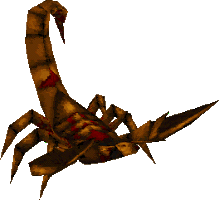 Scorpion Scorpion
Eidolon has bent a race of giant Scorpions to
his will. These creatures are truly horrific: their
deadly sting, combined with their variable size, force
the citizens of Thyrion to continually watch their step. There are two known varieties of
Scorpion: the pale Sand Scorpion, which fights viciously
but lacks the strength of its darker cousin, and the
glossy black Bog Scorpion, whose attacks are notoriously
deadly. Both are best avoided.
|
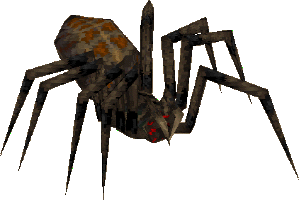 Spider Spider
Just as Eidolon has turned Scorpions into his
footsoldiers, his race of giant Spiders is a plague upon
the land. Like Golems, they come in many different sizes.
There are two distinct varieties of spider, each with its
own color scheme. One sports a black and yellow
coloration, while the other is a muddy brown or red. The
black spider is reputed to be the deadlier of the two,
but the red variety is still a dangerous foe. |
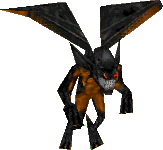 Imp Imp
Among the weakest of Eidolon’s minions,
Imps are nevertheless vicious adversaries. Imps have been
sighted in both the coldest and hottest of Thyrion’s
climes. There seem to be two distinct varieties, each
best suited for a particular extreme of temperature: the
Fire Imp and Ice Imp. They are quite similar in
physiognomy, though the Ice Imps’ bodies are a
frosty blue, and the Fire Imps exhibit a ruddy
coloration.Imps fly upon
leathery bat wings and attack their hapless victims with
magical projectiles of ice or fire–or with vicious,
swooping dives. They are fragile but extremely quick, and
thus quite difficult to kill.
All four continents of Thyrion
are currently plagued with Imps.
|
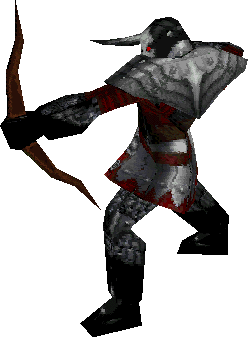 Knight Archer Knight Archer
Eidolon’s minions include a number of human
and semi-human followers. In particular, Eidolon seems to
favor the cadres of deadly archers who heed his beck and
call. The continents of Thyrion veritably swarm with
roving Knight Archers, each seeking to prove his worth by
slaying a foe of Eidolon’s empire.Knight Archers occupy the middle range of
Eidolon’s minions, both in terms of commonality and
power. Their swift arrows can be deadly, while at close
range these archers are forced to punch at their
opponents.
Knight Archers fire enchanted
arrows of two varieties. The standard Archer arrow emits
a greenish glow and deals considerable damage to its
target. The alternate type of arrow glows luminous red,
and knocks the archer’s foes backward with great
force while causing an equal amount of damage as the
green arrows. These red arrows are deadly tools, as they
allow the Archer to buffet nearby foes back to long
range–thus maintaining the optimum distance for
successful archery.
Occasionally the traveler may
encounter commanders of Knight Archer regiments. These
men, known as Archer Lords, are considerably more skilled
(and therefore deadlier) than their common minions.
|
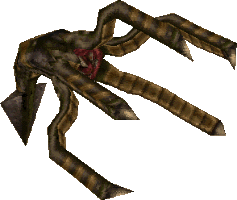 Hydra Hydra
Even as the lands of Thyrion were being
subverted by Eidolon’s minions, the waters were
likewise undergoing a horrific change. Sinewy, tentacled
Hydra now prowl the dank waters surrounding
Eidolon’s strongholds, promising violent death for
the unwary swimmer.Hydra
can rip a victim to shreds with their wickedly barbed
tentacles. When their prey is too far to grapple with,
they spit a corrosive bile that sears the skin and even
tarnishes metal.
It’s a common misconception
that Hydra can harm people on land. While all agree it is
true that Hydra cannot leave the water, some claim they
can rear above the water line and spit their bile at
humans near the water’s edge. The truth of this
frightening story remains to be seen.
|
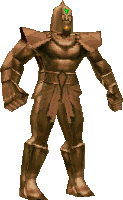 Golem Golem
Golems were the mainstay of Eidolon’s first
assault on Thyrion. These colossal automatons are both
durable and formidable, winning many battles through
sheer intimidation. The typical Golem stands twice the
height of a man, and moves with measured, ponderous
steps. Golems come in many sizes, however.There are reports of several distinct
types of Golem. Though different varieties may appear on
several continents, there are definite concentrations of
particular types on each continent. The mid-sized Iron
Golem, a ponderous creature of iron and lead, plagues the
castles of Blackmarsh and jungles of Mazaera. Deadly and
massive Bronze Golems tread the paved streets of
Septimus, while the relatively diminutive Stone Golems
prowl amongst the pyramids of Thysis.
All Golems love hand-to-hand
combat, where they can crush opponents under their
massive, nerveless feet. Additionally, the larger Iron
and Bronze Golems fire a deadly blast from magical gems
set in their foreheads.
The main challenge in fighting
Golems is to deal enough damage to destroy them. There
are tales of agile warriors who evaded Golems’
attacks with ease, but eventually grew tired of hacking
at their durable opponents, and were forced to give up
and run.
|
  Skull Wizard Skull Wizard
No one knows the origin of the Skull Wizards.
What is known, however, is that they posses immense
magical power. Skull Wizards serve as generals and
councilors to Eidolon, advising him in arcane matters and
overseeing the gradual destruction of Thyrion. Skull Wizards are masters of summoning.
Instead of directly attacking their foes, they like to
summon lesser creatures to do battle in their stead.
Spiders are reputedly their favorite subjects.
When pressed, however, a Skull
Wizard is not incapable of defending itself. It can
summon a magical skull to fire at enemies, and it
teleports short distances whenever it feels genuinely
threatened.
Even in death, the Skull Wizard
is deadly. It is said that a dying Skull Wizard does not
truly die, but instead is transmuted into a host of giant
spiders.
Finally, it is said that the
Skull Wizard is merely a lesser form of an even mightier
creature, the Shadow Wizard. None have seen a Shadow
Wizard and lived to tell of it, but the rumors are so
persistent that its existence seems likely.
|
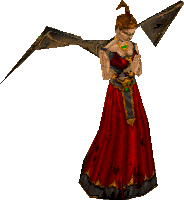 Fallen Angel Fallen Angel
Fallen Angels haunt the decaying castles of
Blackmarsh. Ghostly and ethereal, they possess a surreal,
deceptive beauty. But beware! Fallen Angels rank among
Eidolon’s most deadly minions, and harbor no love
for humans despite their charming appearance.Fallen Angels use magic to harm their
foes. Common attacks include magical bursts that seem to
originate from the Angel’s translucent wingtips, and
a crimson, spiraling bolt of magic that rends everything
in its path.
When attacked, the Fallen Angel
is more than capable of protecting itself. Naturally hard
to see due to their ghostlike transparency, Fallen Angels
further confound their opponents by flying to and fro.
When seriously threatened, the Angel can enfold itself in
its own wings to ward off damage.
|
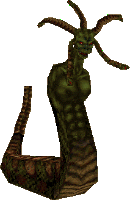 Medusa Medusa
Medusa roam the great cities of Septimus,
inspiring fear in all who tread those flagstoned streets.
A startling combination of woman and snake, the Medusa is
capable of turning her prey to stone with a mere glance.
Her head is crested with snakes instead of hair, and
these snakes spit venom that sears the unwary target.Little else is known of Medusa, for very
few humans have seen one and lived to tell of it.
|
 Mummy Mummy
Travelers in the deserts of Thysis must
constantly be wary of Mummies. These desiccated tomb
dwellers are slow of foot but remarkably hardy. In the
narrow confines of their decaying tombs, speed is less
important than power. Wielding long scepters to good
advantage, Mummies tend to have the upper hand when
fighting in their natural environs. When their foes
retreat to greater distances, however, the Mummy is by no
means helpless. By stamping their scepters upon the
ground, Mummies are capable of summoning flames from the
earth itself, scorching hapless foes who try to run away.One cannot make the mistake of assuming
that a Mummy is dead when its limbs have been severed. So
powerful is its spirit that the Mummy will continue to
attack after vital pieces of its body have been hacked
off. Destroying a Mummy, therefore, is often a slow and
painful process that requires the utmost diligence. Only
when the Mummy has been thoroughly dismembered can an
adventurer rest easy.
|
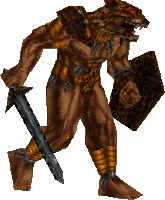 Were-Jaguar Were-Jaguar
The steamy jungles of Mazaera are home to a
particularly deadly foe: the Were Jaguar. Brandishing
serrated swords, Were Jaguars look like a combination of
great cat and conventional footsoldier, but they are
considerably more deadly than either. Were Jaguars are
extremely adept with both sword and shield, hacking and
slashing at medium range, and bashing with their shields
when an opponent draws too close.Were Jaguars are also incredibly fast and
agile. They are known to leap and dive at their foes, and
roll nimbly from side to side in order to dodge attacks.
Occasionally they use their great shields to reflect
incoming projectiles, sometimes even turning these
projectiles back upon their originator.
An even tougher race of Were
Jaguar has recently been sighted in Mazaera. Dubbed the
Were Panther, these beasts are supposedly even stronger
and faster than their common Jaguar cousins.
|
Riders of the
Apocalypse
Four grim generals
carry out Eidolon’s decrees upon the four continents
of Thyrion. The origin of these dread beings is unknown,
but none questions their power: Eidolon himself, it is
rumored, cannot fully control them.These four abominations are known as the
Riders of the Apocalypse. Mounted on dire steeds, these
riders are known by the names War, Famine, Pestilence and
Death. Who can say what dire magic they command, or what
deadly powers they possess? The only certainty is this:
should a wandering hero encounter one of these four
beings, his life is in great peril.
|
Eidolon
Any man or woman who tries to free Thyrion must
do battle with Eidolon himself. Reports of Eidolon’s
appearance and powers are wildly conflicting, though all
agree that he is potent beyond all human reckoning, and
that he bears great resemblance to a creature from a
nightmare. Nothing else
is known of Eidolon’s powers or physiognomy. When
the time comes for a hero to challenge Eidolon’s
dominion, we can only hope that he does not despair at
the sight of this horrific fiend.
|
Artifacts
and Armor
The world of Thyrion has always been
magical. Aside from the mundane trappings of everyday society, it
is relatively common to encounter relics of great power. Here is
a brief catalogue of such items, from the mundane (such as
torches and armor) to the fantastical. Any hero who attempts to
defeat Eidolon will be forced to make good use of these
resources.
Armor
Several types of armor are
widely available in Thyrion. Armor slowly wears away as it
sustains blows, becoming less and less effective until
disintegrating entirely.
Each piece of armor is designed for a
particular body shape and style of fighting. Hence, some armor is
of extra value to certain heroes.
 |
Amulet
Amulets are a magical sort of armor that greatly
benefit spellcasters such as the Necromancer, but are of
considerably less use to brawny warriors such as the
Paladin. |
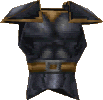 |
Breastplate
The Paladin prefers to wear sturdy breastplates,
and gains great benefits when doing so. However,
breastplates do not fit well upon the Necromancer’s
slight frame, and confer fewer benefits upon him than any
other hero. |
 |
Bracers
Bracers fit over the forearm and are used to
deflect enemy attacks. The deadly Assassin is highly
trained in the use of bracers. Other heroes gain some
benefit from bracers, though the Crusader, who knows
little of their use, is least affected. |
 |
Helmet
The Crusader is accustomed to wearing helmets,
and therefore gains most value from their use. The
Assassin rarely uses this armor type, though, and as such
gains the least benefit from wearing a helmet. |
Artifacts
A sharp-eyed adventurer is
wont to aquire items that aid in the deliverance of our people. A
quick wit and strong arm can only be aided by valuable found
objects.
 |
Torch
The least of any adventurer’s supplies,
torches are nonetheless valuable when exploring the
shadowy places favored by Eidolon’s minions. They
produce light for a brief span, then slowly fade. It is
wise to save them for truly black areas, rather than
expending them in locales where the gloom is merely a
nuisance.
|
 |
Healing
Vial
Healing Vials are used by Eidolon’s minions
to repair minor wounds. The availability of these potions
helps make up for the grievous lack of medics in
Eidolon’s ragged armies. An adventurous hero could
steal any number of these vials, and thereby keep himself
in good health over the course of his travels.
Unfortunately, however, these glass beakers are typically
too fragile to carry: they must be quaffed on the spot. |
 |
Quartz
Flask
Quartz Flasks are a more substantial variety of
Healing Vials. Unlike Vials, which are fragile and
impossible to transport, Quartz Flasks are sturdy
containers that can be ported from place to place. This
portable quality, plus the fact that they’re
substantially more potent than Vials, makes them a handy
resource in battle. |
 |
Mystic Urn
The Mystic Urn is a treasured but unfortunately
rare artifact in Thyrion. Mystic Urns are portable, and
are capable of restoring a grievously wounded hero to
complete health or beyond. Their value, therefore, is
self-evident. |
Mana Crystals
Magic of all kinds is powered by an intangible essence
called mana. Mana suffuses the earth and flows in the wind, but
humans are incapable of tapping into this mana directly. To
harness this mystical energy, magi capture it in specially
designed crystals. Anyone who wishes to cast magical spells or
utilize magical weapons must collect a number of these crystals.
Mana crystals shatter as soon as they are touched, infusing the
recipient with raw magical power.
As with Healing Vials, Mana Crystals are
extremely fragile and cannot be transported, for they would
shatter the instant an adventurer placed them in his pack.
 |
Blue Mana
There are two distinct varieties of mana in
Thyrion: blue and green. Magi trap mana in
different-shaped crystals, the better to easily
distinguish what type of mana is stored therein. The blue
mana crystal is a rare jewel indeed. |
 |
Green Mana
Green mana crystals are no less rare than blue
mana crystals. They are used to power any spells or
weapons that the blue variety cannot affect. |
 |
Combined
Mana
On some occasions, mages capture mana of both
sorts in a single crystal. These crystals are invariably
red, and somewhat larger than the vessels containing blue
or green mana individually. |
 |
Krater of
Might
The ultimate container of mana is called a
Krater of Might. Unlike mana crystals, these vessels may
be carried from place to place and used when necessary.
They contain sufficient power to fully infuse a single
human to maximum mana capacity. |
 |
Chaos Device
Allegedly the fruit of a mad wizard’s
experimentation, the Chaos Device teleports its user to
another part of the world. This effect is not always
predictable, but it’s useful when the user finds
himself trapped in a room with deadly foes. Clever uses of the Chaos Device have been
reported. For example, adventurers have been known to
trigger these devices as they fell to certain death, or
as they struggled for air underwater. The value of a
Chaos Device, therefore, cannot be underestimated.
|
 |
Boots of
Speed
Boots of Speed are created by secretive, unknown
craftsmen. While their original purpose is not apparent
to the average human, one thing is clear: by donning a
pair of these boots, it is possible to attain speeds not
otherwise possible. This extra speed is extremely handy
in combat. |
 |
Disc of
Repulsion
The Disc of Repulsion is a defensive artifact.
When used, it blasts aside projectiles aimed at its user,
and hurls nearby opponents back to a manageable range.
These discs are extremely valuable for deflecting
damaging spell effects. |
 |
Icon of the Defender
Perhaps the most potent artifact in all the
land, the Icon of the Defender is a tremendous boon to
its user. When activated, this artifact renders its
bearer invulnerable for a short period of time. Legends
abound of mighty heroes who used Icons of the Defender to
slay their mightiest enemies, using the protection of the
Icon to best effect by approaching their foes and
attacking at close range.The
Icon’s effects vary slightly when used by different
individuals. The Paladin appears to turn to stone when he
uses the Icon; the Necromancer is shrouded in darkness;
the Assassin phases in and out of existence; and the
Crusader glows with an unearthly light.
|
 |
Tome of
Power
The Tome of Power is a staple of all warrior
guilds. Tomes such as these bestow a supercharging effect
upon both mundane and magical weapons, augmenting their
natural strength, and in some cases producing new effects
altogether. Tomes’ effects are extremely limited in
duration, and are therefore best used when dealing with
particularly deadly foes. |
 |
Seal of the Ovinomancer
Perhaps the most dreaded artifact of all is the
Seal of the Ovinomancer. This terrible creation
transforms an ordinary human (or a lesser monster) into a
brainless sheep! Mages’ guilds have long denied the
existence of these artifacts, but all evidence points to
the fact of their existence.Sadly, the Seal of the Ovinomancer is
useless against the most potent of foes. Thus, a hero
with this Seal could not merely approach Eidolon and
transform him into a lowly sheep. Were this the case, our
beloved planet would already be free of the Serpent
Rider’s blighting presence.
|
 |
Glyph of
the Ancients
The Glyph of the Ancients is a curious artifact
that behaves differently in different heroes’ hands.
When activated by the Crusader, the Glyph acts as a
slow-moving mine that slides across the ground toward its
target–and explodes. The Necromancer drops the Glyph
in place and hurries away from the spot, as it detonates
in just a few short moments. The Paladin throws the Glyph
like a rock and watches as it explodes into a fireball.
Finally, the Assassin drops the Glyph and watches as it
sprouts a magical chain that attaches to a nearby wall.
The Glyph automatically explodes when anyone touches the
chain. |
 |
Force Cube
The Force Cube, sometimes known as the Magical
Square, is a small object that flies up to circle its
owner’s head when activated. As it circles, it
attacks its owner’s enemies with magical beams of
light.The Force Cube
lasts for only a short while, and is therefore best
activated in difficult situations.
|
 |
Stone of
Summoning
The Stone of Summoning allows its user to summon
a giant Imp that smites his foes. This Imp cannot be
directly commanded, and only remains for a short while.
Therefore, as with the Force Cube, the Stone of Summoning
is best used when fighting multitudes of foes. |
 |
Invisibility Sphere
The Invisibility Sphere renders its user ghostly
and ethereal for a short while, thus making him or her
much harder to see and attack. This Sphere does not
render its owner completely invisible, but is
nevertheless an asset in many combat situations. |
Rings
Rings are a special class of magic item unlike all
others. Whereas some items (such as Healing Vials) cannot be
carried to and fro, and other items can be carried and used at
their owner’s leisure, rings fall somewhere in between. They
can be taken from place to place, but the user cannot decide when
or where to use them: their effects are triggered automatically,
and last until the magical power supply has been exhausted.
 |
Ring of
Flight
The Ring of Flight was originally commissioned
by King Yasvim the Unruly as a "gift" for his
bothersome son. When the ring was complete he presented
it to his son, but neglected to mention that its effects
were limited, thus endangering a user that flew too high
for too long. Yasvim was notorious for his cruel pranks.Later the ring was copied by magicians
throughout the land, and while not exactly common, the
Ring of Flight can be found in many secret places
throughout the lands of Thyrion.
As the name suggests, the Ring
of Flight bestows the power of flight upon its wearer.
Flight begins as soon as the ring is picked up, and lasts
for a limited time. The wearer cannot "turn on"
or "turn off" this effect to conserve power, so
effective use of the Ring is not always easy.
|
 |
Ring of
Water Breathing
The Ring of Water Breathing allows its wearer to
breathe freely underwater. The ring automatically comes
into use when the wearer is underwater, and stops being
used when the wearer surfaces. The ring’s magical
energy is only drained while the ring is actually being
utilized. |
 |
Ring of
Regeneration
The Ring of Regeneration slowly restores its
wearer to full health whenever he or she is injured. The
ring does nothing when the wearer is at full health; its
magical energy is only drained while the ring is busy
healing its owner. |
 |
Ring of Reflection
The Ring of Reflection occasionally reflects
projectiles that have been fired at its wearer. This
effect is not guaranteed: sometimes the ring works, and
sometimes it doesn’t. Magical energy is only drained
from the ring when it successfully deflects a projectile. |
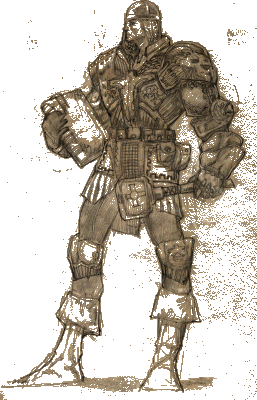 The
Crusader
The
Crusader
In my visions, I have seen four
mismatched heroes who seek to destroy Eidolon. The following
pages chronicle my visions, imparting what I have seen of each. I
know none of their names, but by observing them time and again in
my dreams, I have come to know the heart of each. The first
figure of my visions is a Crusader.
The Crusader is a holy man and a healer.
Armed with both his faith and an array of mystical weapons, he is
a staunch opponent of Eidolon. His superb defensive skills and
mystical powers make him extremely hardy and resistant, and will
serve him in good stead on his upcoming quest.
The Crusader’s Abilities
Though not the most formidable of adversaries,
the Crusader has several abilities that greatly aid his chances of survival.
Indeed, the Crusader is perhaps the hardiest of the four heroes, armed only
with the favor of his god to protect him.
The Crusader has the power to
periodically heal himself, though this power is not completely
under his own control. As he fights the enemies of Thyrion, he is
constantly learning and gaining insights. It is during his most
intense combats, and hence his most intense periods of learning,
that his body is apt to be completely restored. In this way, the
Crusader’s god rewards action over sloth.
Occasionally, when the Crusader slays an
enemy, a magical sphere appears over the corpse of his foe. This
sphere represents the vitality and power of the enemy. By
collecting this sphere the Crusader is able to partake of his
opponent’s power and add it to his own. For a brief time his
strength is superhuman, and he can perform feats of unlikely
heroism. Eventually this power fades, however, and the Crusader
returns to normal strength.
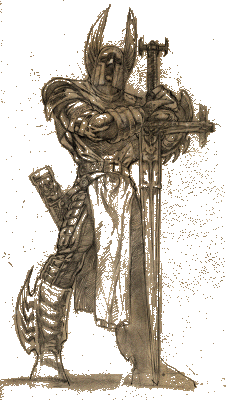 The Paladin
The Paladin
The Paladin, like the Crusader, is a
holy man. But while the Crusader is principally a healer, and his
skills emphasize defense, the Paladin is a true warrior. The
favor of his warlike god protects him, but also gives him
strength to smite his foes.
Few can match the Paladin in single
combat. He lacks stealth and subtlety, instead relying on his
mighty weapons and divine favor.
The Paladin’s Abilities
During endless hours of training, the
Paladin has pushed his abilities to new levels. Invoking the power of his god,
he has developed magical powers unknown to the common human.
Kravnos the war god has an affinity for
water. As a minion of Kravnos, the Paladin is capable of moving
underwater without the same restrictions as a normal human. While
others are forced to laboriously swim, the Paladin traverses the
depths as if they were air instead of water. When engaged in
battle with a river or lake nearby, he prefers to carry the
battle underwater, where he can use this ability to great
advantage.
When brought to the brink of death by
his enemies, the Paladin sometimes receives a great boon from
Kravnos. As the lethal blow lands, the Paladin does not die.
Rather, he enters a mystical state: he grows in strength and
stature and becomes a holy scourge, seeking to avenge the
evildoers who tried to lay him low. In this state the Paladin
cannot be killed, and his powers grow to otherwise impossible
heights.
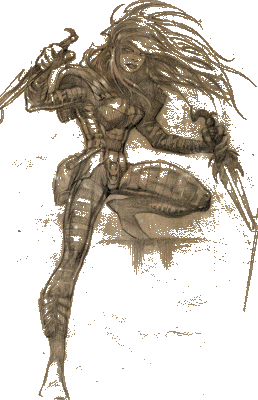 The Assassin
The Assassin
The Assassin is a master of stealth,
disguise, and trickery. Whereas the Paladin rushes into combat
with a mighty roar, the Assassin sneaks up from behind. Many of
the Assassin’s weapons and skills are geared toward trickery
and concealment. From her devastating ability to backstab an
opponent to the deadly Hand Crossbow, it is clear the Assassin is
always ready for an unfair fight.
The Assassin’s Abilities
The Assassin is a master of stealth and
deadly strikes. The first noteworthy ability the Assassin gains is that of stealth:
she can render herself invisible when standing perfectly still in a shadowed
area. It takes a few seconds for her to achieve this invisibility, but once
attained, the illusion is perfect. It is rumored that Assassins can master this
skill in broad daylight when their skills are all but perfected.
The Assassin makes very little sound
when moving, and is often able to surprise her victims. Creeping
up from behind, she strikes before her foes acknowledge her
presence. When attacking in this fashion, she is capable of
dealing much more damage than she otherwise would. This ability
also comes into play when the Assassin strikes a foe who knows of
her existence, but allows her to get behind him. This is a rare
occurrence, but occasionally significant when she fights sluggish
opponents such as Golems.
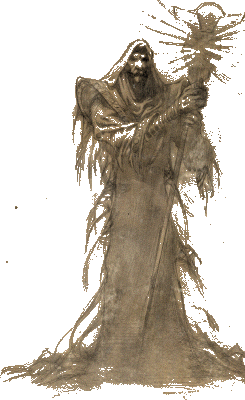 The Necromancer
The Necromancer
The Necromancer is a self-styled lord of
the dead. Though physically weak, his potent magic and dark
talents make him a formidable combatant. He likes to fight from a
distance, where his powerful ranged weapons can decimate even the
most formidable of enemies.
The Necromancer’s Abilities
The Necromancer’s skills are truly
unique, and most of them revolve around Soul Spheres. When the Necromancer slays
an opponent, a Soul Sphere is left behind. This sphere is invisible to all but
the Necromancer. It represents the life force and vitality of the recently-slain
foe. The Necromancer may collect a Soul Sphere simply by touching it, thus collecting
the energy in the form of mana or healing. As the Necromancer gains skill, his
chances of benefiting from a Soul Sphere slowly increase.
Soul Spheres quickly lose their potency,
so the Necromancer must be swift!
The Necromancer’s sickle is also a
source of power. Whenever the Necromancer strikes a foe with this
sickle, he has a chance to drain vitality from his opponent and
add to his own health. This is not a common or predictable
occurrence, but it is often helpful when the Necromancer enters
precarious situations.
A
Bitter Farewell
It is with heavy hand and heavy heart,
dear reader, that I lay down my pen. I had hoped to write a full
chronicle of the attack on Eidolon, documenting these four
unlikely heroes’ quest to banish him from our world. But now
I must abandon my work, for my hiding place has been discovered.
Golems and Fire Imps will soon swarm through this place,
destroying all that they find here. There is no help for it; I
must flee for my life.
The future is uncertain. I have seen it
in scattered visions, but the play’s final act has not been
performed. Perhaps it is not yet written. Whatever the case, I
pray that one of these four heroes succeeds in their quest. If
not, this history–and the world that it chronicles–will
be forever lost to darkness. I pray it is not so.
–Themedes, Sage of Mur
Hexen II™ ⌐ 1997 Raven Software
Corporation. All Rights Reserved. Id Software, Inc. software code
contained within Hexen II™ ⌐ 1996 Id Software, Inc. All
Rights Reserved. Developed by Raven Software Corporation.
Published by Id Software, Inc. Distributed by Activision, Inc.
under sublicense. Hexen™, Hexen II™ and the Raven
logo are trademarks of Raven Software Corporation. The Id
Software name and the id logo are trademarks of Id Software, Inc.
Activision« is a registered trademark of Activision, Inc. All
other trademarks and trade names are the properties of their
respective companies.
All images contained on this
disk are the property of Activision, Inc., and may not be used
without the written concent of Activision, Inc.
 It was precisely one year ago that
Eidolon came to our world of Thyrion. On the evening
before his arrival, a rain of fire streamed down from the
sky, scorching citizens and buildings alike on the four
continents of our fair planet. By dawn the populace was
fearful and demoralized, and they fell quickly before the
march of Eidolon’s vile Golems. The attack was bold
and carefully executed. All four continents had fallen by
midday: a sad tribute to the withered resistance of our
four mighty nations. Even now I am shamed to think of it.
It was precisely one year ago that
Eidolon came to our world of Thyrion. On the evening
before his arrival, a rain of fire streamed down from the
sky, scorching citizens and buildings alike on the four
continents of our fair planet. By dawn the populace was
fearful and demoralized, and they fell quickly before the
march of Eidolon’s vile Golems. The attack was bold
and carefully executed. All four continents had fallen by
midday: a sad tribute to the withered resistance of our
four mighty nations. Even now I am shamed to think of it. Several hundred
years ago, in the time we now call the Age of Dreams,
there were rumors of the Serpent Riders. The Serpent
Riders were a trio of horrifying demons, wielding
powerful magic and commanding vast, formidable armies.
They possessed the power to travel from world to
world–and everywhere they went, they spread chaos
and despair. Their motives were unclear, but their goals
were obvious: they wished to possess. That which they
could not possess, they strove to destroy. No world was
immune, not even our beloved Thyrion.
Several hundred
years ago, in the time we now call the Age of Dreams,
there were rumors of the Serpent Riders. The Serpent
Riders were a trio of horrifying demons, wielding
powerful magic and commanding vast, formidable armies.
They possessed the power to travel from world to
world–and everywhere they went, they spread chaos
and despair. Their motives were unclear, but their goals
were obvious: they wished to possess. That which they
could not possess, they strove to destroy. No world was
immune, not even our beloved Thyrion. In ages past, the steppe dwellers of
Kazul-Mokh prophesied the coming of Eidolon and his
brethren. But to understand their stories, one must first
understand their view of the universe.
In ages past, the steppe dwellers of
Kazul-Mokh prophesied the coming of Eidolon and his
brethren. But to understand their stories, one must first
understand their view of the universe.  D’Sparil
D’Sparil Korax
Korax Scorpion
Scorpion Spider
Spider Imp
Imp Knight Archer
Knight Archer Hydra
Hydra Golem
Golem
 Skull Wizard
Skull Wizard Fallen Angel
Fallen Angel Medusa
Medusa Mummy
Mummy Were-Jaguar
Were-Jaguar

















